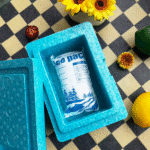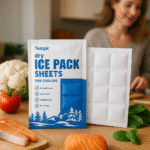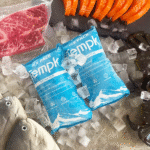Can Dry Ice Damage the Cooler Lining in a Bag?
Dry ice is widely used for keeping perishable items frozen, especially during long shipments or outdoor activities. Jedoch, the question remains: Can it damage the cooler’s lining when placed in a bag? The answer depends on the cooler material, packing methods, and precautions taken. This guide will explore the risks and provide actionable advice to ensure your cooler stays intact while benefiting from the long-lasting cold that dry ice offers.
-
Wie dry ice interacts with cooler linings: The science behind temperature differences and potential damage.
-
Does using dry ice in a bag affect cooler integrity?: Understanding the role of bags in protecting cooler linings.
-
What precautions should you take when using dry ice in coolers?: Key safety measures and best practices.
-
How to choose the best cooler for dry ice: Cooler materials that can withstand the extreme cold of dry ice.
How Does Dry Ice Interact with Cooler Linings?
Trockeneis, aus massivem Kohlendioxid hergestellt (Co₂), is incredibly cold, reaching temperatures as low as -109° F (-78.5°C). Bei einem Kühler platziert, it draws heat from the surrounding environment, causing the temperature inside to plummet rapidly.
Can Dry Ice Damage Your Cooler Lining?
Ja, dry ice can damage the cooler lining if not handled carefully. The extreme cold of dry ice can cause materials like thin plastic or fabric to become brittle and crack, especially when the cooler is not adequately insulated. If dry ice directly contacts the cooler’s lining, it may lead to cracks, warping, or even degradation of the material over time.
Why Cooler Material Matters
Coolers made from thin plastics or fabrics are more susceptible to thermal shock. This is why high-quality, rotomolded coolers are better suited for dry ice use as they are designed with thicker insulation and durable materials.
Does Using Dry Ice in a Bag Affect Cooler Integrity?
Using a bag with dry ice can offer some protection but is not foolproof. A bag serves as a barrier to contain the dry ice, preventing direct contact with the cooler’s lining. Jedoch, the bag does not offer sufficient insulation to fully protect against thermal shock from dry ice. daher, it’s important to add a protective layer like Karton oder Schaum between the dry ice and the cooler’s interior.
Warum ist die Belüftung wichtig??
Dry ice sublimes into Kohlendioxidgas, and if this gas is unable to escape, it can build up pressure inside the cooler. This can damage the cooler’s seals and increase the risk of the cooler bursting. To avoid this, ensure the cooler is ventilated by leaving the lid slightly ajar or removing the drain plug.
How to Protect Your Cooler When Using Dry Ice
To avoid damage to your cooler and enhance its lifespan, follow these expert recommendations:
-
Wählen Sie den richtigen Kühler: Opt for a rotomolded cooler with thick walls and strong insulation. These coolers are best suited for dry ice use and can withstand extreme temperatures. Soft coolers or cheap plastic ones should be avoided when using dry ice.
-
Use Insulating Barriers: Verwenden Sie immer a Karton oder foam barrier between the dry ice and the cooler’s lining to distribute the cold more evenly and prevent direct contact.
-
Wrap the Dry Ice: Wrapping the dry ice in newspaper oder a cloth bag helps slow down sublimation and protects your cooler from extreme cold.
-
Belüftung: As dry ice releases carbon dioxide gas, proper ventilation is critical. Make sure the cooler is vented to prevent dangerous gas buildup.
What Are the Risks of Using Dry Ice Without Proper Precautions?
When used incorrectly, dry ice can present several risks:
-
Erfrierung: Dry ice can cause severe frostbite on contact with skin. Always handle it with protective gloves oder Zange.
-
Erstickungsgefahr: In poorly ventilated spaces, the sublimation of dry ice can displace oxygen, was zu Erstickungsrisiken führt.
-
Damage to Cooler Lining: As discussed, the extreme cold from dry ice can cause cracks or warping in the cooler lining if it’s not properly insulated.
How to Choose the Best Cooler for Dry Ice?
When selecting a cooler for dry ice, Betrachten Sie die folgenden Faktoren:
-
Heavy-Duty Insulation: Choose coolers with thick foam or polyethylene insulation that can handle extreme cold.
-
Ventilation Features: Coolers with built-in ventilation systems or airflow vents are ideal for dry ice use.
-
Haltbarkeit: High-quality rotomolded coolers last longer and provide better protection against thermal shock.
| Kühlertyp | Isolierung & Dicke | Dry Ice Suitability | Praktischer Rat |
|---|---|---|---|
| Rotomolded Coolers | Dick, seamless polyethylene | Highly suitable with ventilation | Ideal for long-term use with dry ice |
| Injection Molded Coolers | Medium insulation, less thick walls | Suitable with precautions | Use a barrier between dry ice and cooler lining |
| Soft Coolers | Thin insulation, fabric | Not recommended for dry ice | Avoid or use with extreme caution |
2025 Trends in Cooler Design for Dry Ice Use
Wie wir eintreten 2025, cooler manufacturers are developing more sophisticated solutions for dry ice storage:
-
Verbesserte Isolationsmaterialien: Neu, advanced materials are being used in cooler linings, wie zum Beispiel Aerogele Und Phasenveränderungsmaterial (PCMs), which offer enhanced insulation properties without compromising weight.
-
Eco-Friendly Designs: Sustainable coolers made from biodegradable materials are gaining traction, while maintaining the durability needed for dry ice use.
These innovations are set to make coolers safer, effizienter, and better equipped to handle the extreme cold of dry ice.
Häufig gestellte Fragen
Q1: Can dry ice damage my cooler’s lining if used for short periods?
Dry ice can damage cooler linings if exposed for extended periods. Jedoch, using coolers with thick insulation and protective barriers can help prevent damage during short-term use.
Q2: Can I use dry ice in soft coolers?
Using dry ice in soft coolers is generally not recommended, as the material is too thin to handle the extreme cold. Falls nötig, ensure you use a thick foam barrier and ventilate the cooler properly.
Q3: Wie lange dauert Trockeis in einem Kühler??
Dry ice lasts approximately 18–36 Stunden Abhängig von der Isolierung des Kühlers, Die Menge an Trockeneis verwendet, and the external temperature.
Schlussfolgerung und Empfehlungen
Dry ice can cause significant damage to cooler linings, especially when not used properly. By following the right precautions—such as using insulating barriers, selecting the appropriate cooler, and ensuring ventilation—you can safely store perishable items for extended periods. Opt for high-quality coolers and always take protective measures to extend the life of both your cooler and dry ice.
Nächste Schritte:
-
Always use insulating materials like cardboard or foam to prevent direct contact with the cooler lining.
-
Choose coolers specifically designed for dry ice use, with proper insulation and ventilation.
-
Regularly check your cooler’s condition after using dry ice to maintain its efficiency.
Über Tempk
Und Tempk, we specialize in providing high-performance coolers built for extreme conditions. Our coolers are equipped with top-tier insulation, ventilation systems, und umweltfreundliche Materialien, making them ideal for storing dry ice and perishable items. Contact us today to find the perfect cooler for your cold chain needs.
























